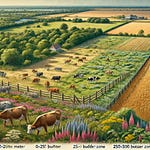The Netherlands has been grappling with a complex nitrogen crisis for years, leading to heated debates and significant policy challenges. At the heart of the issue are questions about how nitrogen compounds, particularly ammonia (NH₃) from agriculture, spread through the atmosphere and deposit on sensitive natural areas. Official policy heavily relies on atmospheric transport models like OPS/AERIUS to calculate nitrogen deposition and inform permitting decisions.
However, a new series of scientific reports by Ir. Wouter de Heij, an R&D and innovation expert in food technology, is challenging some of the fundamental assumptions underpinning this policy. Drawing on new measurements, model analyses, and literature, his second report, "Ammonia above and in the Netherlands: A scientific overview (part 2)," along with related articles on Foodlog.nl, presents a compelling case for revising how we understand and regulate nitrogen emissions and deposition.
The Core Hypotheses: Local Deposition and Emission Overestimation
De Heij's work centers around two main hypotheses:
Ammonia spreads primarily locally: Contrary to the assumption that ammonia diffuses widely across the landscape, the research suggests it deposits much closer to its source, often within a few hundred meters.
Emissions are overestimated, and deposition calculation is inaccurate: The official emission figures (NEMA) are argued to be too high, especially for certain livestock sectors, and the models used to calculate deposition are not sufficiently accurate, particularly at a local level.
These hypotheses stem from the observation that new insights from measurements, models, and local dispersion of ammonia don't align with current policy assumptions. The report aims to provide a better understanding of the spatial distribution of ammonia and the reliability of models like OPS/AERIUS.
Challenging the Dispersion Models: What the Data Says
Measurements and alternative modeling approaches suggest that ammonia concentration decreases exponentially with distance from a stable. According to De Heij's adapted Gaussian Plume model, concentrations become negligible at a distance of a few hundred meters (circa 250-500 meters). This is supported by field measurements and sensor research.
This finding directly contrasts with the OPS model's predictions. While OPS simulations estimate that only about 5-9% of total ammonia emission is deposited within a 500-meter radius around the stable, measurements near farms suggest significantly higher local deposition. For example, a UvA study measured high bulk NH₄⁺-depositie (48.6 kg NH₄⁺-N ha⁻¹ y⁻¹ at 15m) and NH₃ concentration (34.0 µg NH₃-N m⁻³ at 15m) near a dairy farm, values substantially higher than those calculated by OPS directly at the stable (around 600 mol/ha/year, equivalent to roughly 8.5 kg NH₃/ha/year). This indicates that OPS might significantly underestimate local ammonia deposition.
Further analysis using KringloopWijzer (KLW) data from dairy farms suggests that the actual percentage of ammonia redepositing on the farm's own land could be much higher, ranging from 25% to 75%, with a median around 50%. This is far greater than the approximately 4% calculated by the current RIVM model for local deposition on the farm. De Heij introduces the concept of an "ammonia saldering percentage," similar to solar power net-metering, where higher uptake on owned land reduces the burden elsewhere.
Emission Factors Under Scrutiny
The reports also argue that the official NEMA emission factors, particularly for dairy farming, are too high. While the total number of animals in the Netherlands might have relatively small uncertainty, practice measurements and KLW data indicate that the actual emission factors for dairy cattle (per livestock unit, GVE) are lower than assumed in NEMA calculations.
An analysis of nearly 50 KLW records showed an average stable emission of 11 kg ammonia per animal place per year, contradicting critique suggesting emissions might be higher than 13-14 kg. This aligns with recent WUR practical research reporting stable emissions between 8.5 and 10 kg ammonia per dairy cow. De Heij suggests that the overestimation for dairy specifically contributes to a structured over-calculation of emissions for this sector. Analysis is also underway for the pig and poultry sectors to see if similar overestimations exist.
Based on these adjusted emission factors and updated animal numbers, the estimated total ammonia emission from the livestock sector for 2025 is around 73 million kilograms, a 13% drop compared to 2021.
Grasslands as a Significant Sink
A crucial insight is the role of grasslands and fodder crops (maize) as a substantial sink for reactive nitrogen. With over 1.16 million hectares dedicated to these uses in the Netherlands, these areas absorb significant amounts of nitrogen from the atmosphere through dry and wet deposition of both ammonia (NH₃) and nitrogen oxides (NOₓ).
Estimates based on KLW data, COTAG measurements, and literature suggest that total nitrogen deposition on agricultural land (including dry and wet deposition of both NH₃ and NOₓ) is around 22 kg nitrogen per hectare per year. This high uptake capacity means that a significant portion of ammonia emissions from nearby sources is likely redeposited on agricultural land itself. This positions the ground-based dairy farming sector as potentially the only economic sector that functions as a net nitrogen-sink on a large scale.
Critique of Models and Feedback
The report is critical of the heavy reliance on models like OPS/AERIUS for policy and permitting, especially at local and ultra-local scales. The scientific literature points to significant limitations and uncertainties in these models at fine scales, often exceeding 70%. Furthermore, calculation results below 1 mol/ha/year are deemed scientifically unreliable for specific project decisions due to insufficient certainty to distinguish them from zero.
The author engaged with RIVM and other experts, receiving feedback that is included in the report. While RIVM appreciated the engagement, they raised concerns about insufficient literature consultation, missing assumptions, and lack of reproducibility in De Heij's work. De Heij responded to specific points, requesting references for RIVM's claims of potentially higher stable emissions and acknowledging the complexity of atmospheric processes and the limitations imposed by research budget on formal publication. He maintains that multiple signals point to lower, not higher, stable emissions than assumed by NEMA.
Historical Events and Policy Effectiveness
Analyzing historical events involving significant reductions in livestock numbers – such as the pig plague (1997), Foot-and-Mouth Disease (2001), and the phosphate reduction plan (2017) – revealed no structural observable effect on measured atmospheric ammonia concentrations. This finding challenges the direct, model-based assumption that changes in livestock numbers automatically lead to proportional, measurable changes in atmospheric ammonia levels.
Based on this, the report predicts that the effects of recent voluntary buyout schemes (Lbv and Lbv+), which aim for a reduction of 2.7 kilotons of ammonia emission, will likely not be detectable in existing measurement networks.
Implications for Policy
The findings suggest a need for a fundamental revision of the Dutch nitrogen policy. If ammonia deposits mostly locally and existing models underestimate this while overestimating total emissions, the current policy, heavily reliant on these models for permits far from sources, might be misdirected.
The report advocates for:
Revising models to better reflect local deposition based on practical measurements.
Implementing finer-grained monitoring.
Adopting area-specific policies that account for local conditions and the actual contribution of sources near nature areas.
Focusing on tailored solutions, buffer zones, and farm-specific monitoringrather than generic measures like mass buyouts, which are deemed financially inefficient and socially controversial.
Developing and implementing innovations and proven techniques.
De Heij suggests that significant emission reductions are achievable with a different approach, estimating a potential 40-50% reduction within a total budget of €5.3 to 8.4 billion over 10 years (2025-2035).
By making scientific insights accessible and engaging in public debate, De Heij aims to contribute to a more transparent, careful, and knowledge-driven approach to the nitrogen crisis. The core message is clear: understanding the real-world behavior of ammonia and basing policy on robust practical data is essential for finding effective and fair solutions.











Share this post